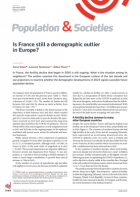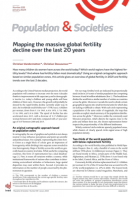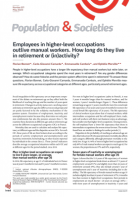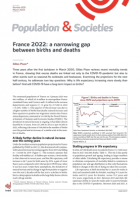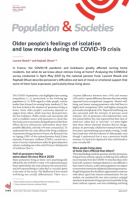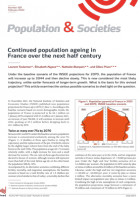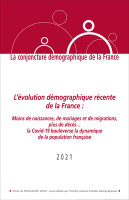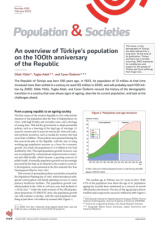
An overview of Türkiye’s population on the 100th anniversary of the Republic
Population and Societies
n° 608, February 2023
https://doi.org/10.3917/popsoc.608.0001
International Institute for Applied Systems Analysis (IIASA), Vienna Institute of Demography, Austrian Academy of Sciences (VID/ÖAW)
Centre for Longitudinal Studies, UCL Social Research Institute
Zonguldak Bülent Ecevit University, Labour Economics and Industrial Relations
The Republic of Türkiye will celebrate its 100th anniversary in October 2023. Since its foundation, the country’s population has grown from 13.5 million in the first census in 1927 to 84.7 million in 2021. The total fertility rate has dropped from 6 births per woman to fewer than 2 over the same period. With a steady decline in mortality, the population is beginning to show the first signs of ageing. Additionally, Türkiye, once a country of origin, has gradually become a transit and host country for migrants, mainly from Syria and other Middle Eastern countries. The intention to emigrate from Türkiye is high among young people due to the uncertainty of the country facing economic crises and high unemployment.
Türkiye, Turkey, demographic transition, population, population growth, fertility, births, mortality, migration
Table of contents
- Appendix A References
1.
The Republic of Türkiye was born 100 years ago, in 1923. Its population of 13 million at that time increased more than sixfold in a century to reach 85 million in 2020, and will probably reach 100 million by 2060. Dilek Yildiz, Tugba Adali, and Caner Özdemir recount the history of the demographic transition in a country that now shows signs of ageing, describe its current population, and look at the challenges ahead.
1.1. Notification :
- Editor’s note: In this version, amended on 8 March 2023, a paragraph on migration and a sentence relating to the period before the foundation of the Turkish state have been modified because they would have required more development. INED does not forget the massacres of the Armenian population perpetrated on Ottoman territory before 1923. (Previous version)
- This issue, on the demography of Türkiye, has been planned for a long time. At the time of its publication, Türkiye and Syria are in terrible mourning. INED expresses its condolences and support to the people of Türkiye and Syria suffering from tragic loss.
1.1. From a young republic to an ageing society
The first census of the modern Republic in 1927 reflected the situation of the population after the War of Independence (in 1922), with high fertility and mortality rates, and a shortage of young men. This led the government to adopt pronatalist policies, such as a lowering of the legal age of marriage (15 years for women and 16 years for men in the 1938 civil code), and symbolic incentives, such as medals for women who had more than 6 children. These policies were pursued during the first several decades of the Republic, with the aim of using working-age population increase as a lever for economic growth. As a result, the population of 13.5 million in 1927 had doubled by 1960. This rapid population growth, however, was not accompanied by commensurate improvements in maternal and child health, which became a growing concern of public health. Eventually, population growth was increasingly perceived by the State as an obstacle to the country’s economic development, as documented in the first national Five-Year Development Plan for 1963–1967.
This reversal of pronatalist policies was further enacted by the Population Planning law of 1965, which introduced widespread contraception and family planning services in many primary healthcare facilities. The population growth rate, which peaked in the 1950s at 2.8% per year, had declined to 1.3% by 2021.1 Under the main scenario of the official population projections (TURKSTAT, 2022), the population growth rate will continue to decline, with the total population stabilizing at just above 100 million by around 2060 (Figure 1).
The median age in Türkiye was 33.1 years in 2021. With 9.5% of the population now above the age of 65, population ageing has recently been mentioned as a concern in several official policy documents. The size of this age group is almost 8 million and is expected to exceed 27 million by 2080. Figure 2 shows the ageing process, with the projected population age structure in 2080 compared to that of 2020.
1.2. Transition to low fertility
While fertility rates were generally high in the early 20th century, some cities like Istanbul and Izmir were the pioneers of the demographic transition, with fertility rates that had already started to decline in the 19th century. Istanbul’s total fertility rate (TFR), for instance, was estimated at 3.5 births per woman by the 1885 Ottoman Census (Behar, 1995). However, the country was predominantly rural, and the national TFR during the first decade of the Republic, in the 1920s, was around 6 children per woman. This rate peaked at 7 in the 1930s.
The Population Planning law of 1965 legalized all types of contraception (excluding sterilization) and allowed abortions in medical emergencies. Accordingly, contraceptive use (traditional and modern) increased from 22% in 1963 (with almost no modern methods) to 38% in 1978 (with 21% modern methods). While these developments accelerated the fertility decline, they provide only a partial explanation (Behar, 1995). Another major factor is rapid urbanization that led to shifts in family types, with a transition from extended to nuclear families. Wider educational opportunities in urban areas also contributed to fertility decline.
Following the 1983 Population Planning law that legalized abortion and sterilization on demand, the TFR fell below 3 in the 1990s. It fluctuated around replacement level of 2.1 until 2017 and decreased to 1.7 in 2021, according to TURKSTAT (2022) (Figure 3).
While the 1983 law is still in force, the State’s approach towards fertility and abortion has visibly shifted. Recep Tayyip Erdoğan, who has been in power for the last 20 years, first as prime minister, then as president, has made public statements encouraging couples to have at least 3 children and single people to marry, especially young people, and condemning abortion on demand. These views on abortion, supported by the members of his political party, appear to have adversely affected service provision, with recent studies indicating that abortion on demand is now only provided by a handful of public hospitals.
1.3. Improvements in mortality
The first available estimates of mortality in modern Türkiye date back to the 1930s. With few people surviving to older ages, the overall estimate of life expectancy at birth for 1935–1940 was 35.4 years (Shorter and Macura, 1983). This low level dipped even further during the Second World War, falling to 31.4 years over the next 5 years, even though Türkiye was not a belligerent. The economic constraints of this era took their toll on the population in the form of poverty and food scarcity. This resulted in infant mortality rates (IMR) that rose from 273 to 306 per 1,000 births between 1935–1940 and 1940–1945.
Improvements in mortality have been mostly steady since then. Life expectancy at birth reached 50 years in the 1960–1965 period, and the IMR fell to 176 per 1,000 (Shorter and Macura, 1983). Policy measures targeting maternal and child health, such as the national vaccination campaign of 1985, raised awareness of preventive care in the 1980s. In the 1990s, however, the IMR did not decline as rapidly as in other countries with similar levels of economic development.
In the 2000s, prenatal care became more widespread, leading to a decline in infant mortality. According to the Demographic and Health Surveys (HUIPS, 2021), the proportion of pregnant women receiving antenatal care increased from 62% to over 95% from 1993 to 2018; and deliveries in healthcare facilities increased from 60% to 99% in the same period. Likewise, the proportion of children under 5 years suffering from chronic malnutrition decreased from 19% to 6%. Thanks to these healthcare improvements, Türkiye was among the first concerned countries to meet Millennium Development Goal 4 to reduce under-5 mortality by two-thirds between 1990 and 2015.2 As of today, the IMR is below 15 deaths per 1,000 births, with life expectancy above 75 years for both sexes (Figure 4).
The effect of the COVID-19 pandemic on mortality is yet to be assessed. According to the Ministry of Health, as of the end of November 2022, 101,492 lives have been lost due to the pandemic since its onset. However, official annual statistics of deaths and causes of death for 2020 and onwards have not been released.
1.4. Internal migration
In 2012,3 77% of the Turkish population lived in urban areas, compared with just 24% in the early 20th century according to the first census in 1927. Migration from the countryside to the cities was the main pattern of internal migration for several decades. Urban-to-urban migration is also a longstanding phenomenon, and became dominant after the major waves of rural-to-urban migration slowed down in the 1980s. Historically, internal migrants have tended to move towards the western regions of Türkiye, to cities like Istanbul and Izmir. The other regions have been mostly sending regions. This pattern remains valid with a few exceptions.
Internal displacement is another feature of Turkish history. The resettlement of non-Turkish minorities in places deemed appropriate by the government, already frequent in the early years of the Republic, became official policy with the 1934 Settlement law.4 Towards the end of the 20th century, mainly between 1986 and 1995, the conflict between the Turkish State and the Kurdish separatist movement led to mass population displacement, mainly of Kurdish people, from eastern Türkiye. It is estimated that a million people were internally displaced from the 14 eastern provinces between 1986 and 2005 (HUIPS, 2021).
1.5. International migration
Since its foundation as a new nation state in 1923, international migration to and from Türkiye has been intertwined with its rapid demographic, economic, and social transition, as well as the major events that took place in neighbouring countries. It has been a country of emigration, immigration, and asylum (Kirişçi, 2003), and of transit migration in the last several decades.
Between the end of the Second World War and the 1990s, over a million people migrated to Turkey from communist regimes, such as Yugoslavia and Bulgaria. At the same time, treaties between Türkiye and various Western European countries, such as Germany, made way for labour migration from Türkiye to states in need of workers in the post-war period. While some of these workers returned, most stayed and were joined by their families from Türkiye through family reunification in the 1980s and 1990s. The 1980 military coup and the situation in Kurdish regions accelerated demand for political asylum from Türkiye (İçduygu and Sirkeci, 1999). According to the Turkish Ministry of Foreign Affairs, more than 6.5 million Turkish nationals currently live abroad, of whom 5.5 million in a Western European country. TURKSTAT reports that the annual flow of Turkish nationals emigrating from Türkiye increased from 69,000 in 2016 to 84,000 in 2019.5 Five-year immigration and emigration flows between 1990–1994 and 2015–2019 are illustrated in Figure 5.
Starting from the 1990s, Türkiye became a major country for transit migration, temporarily hosting people from countries like Afghanistan, Iran, and Iraq. Having signed the 1951 Convention with a ‘geographical limitation’, Türkiye does not provide refugee status to these migrants, limiting this status to those arriving from Europe; the United Nations High Commissioner for Refugees (UNHCR) is the agency that processes their resettlement applications. The 2011 Syrian crisis, on the other hand, has affected the status granted to arrivals seeking refuge or asylum. Three million Syrians arrived in Türkiye between the beginning of the crisis and 2016. From 2014, they were granted ‘temporary protection’ status, which, contrary to refugee status, does not qualify them for resettlement in a third country. According to the Directorate General of Migration Management, Türkiye hosts 3.6 million people as of November 2022 under this scheme. About half a million Syrians have left Türkiye irregularly, mostly taking the sea route to Greece (UNHCR estimates for sea arrivals of Syrian Arab Republic nationals to Greece peaked in 2015 with 483,730 arrivals vs. 23,200 the previous year). An agreement between the European Union and Türkiye was signed in 2016, whereby all irregular migrants crossing from Türkiye to the Greek islands are returned to Türkiye. This dramatically reduced the number of people moving to Greece from Türkiye from 2016 onwards.
1.6. Looking to the future
The working-age share of the population is still large enough for Türkiye to benefit from a demographic dividend associated with increasing levels of education: the share of the population over age 25 with university or higher education rose from 9.1% in 2008 to 20.8% in 2019. To exploit this window of opportunity, human capital must be used to full capacity. However, as of 2022, 27.1% of young people aged 15–24 were not in education, employment, or training. Moreover, unemployment reached its highest level in the history of the Republic in 2020, and women’s employment rate has stagnated at around 30% for many years.
As the largest refugee-hosting country in the world, the economic consequences of the COVID-19 pandemic and high unemployment rates among the young population pose challenges for the future of Türkiye. Considering the low fertility and mortality levels, future outgoing and incoming migration flows could have a major impact on the population structure in the next decades. Emigration among the young and skilled population towards developed countries may increase in the medium term,6 especially in response to the country’s currency crises and the worsening political atmosphere after the failed coup attempt of 2016. Trends in immigration, on the other hand, will probably be shaped by developments in Afghanistan, Syria, and the Middle East in general. The extent of migration and related integration policies will thus be decisive for the future population structure of Türkiye.
Appendix A References
-
Behar C., 1995, The fertility transition in Türkiye: Reforms, policies, and family structure, in Makhlouf Obermeyer C. (ed.), Family, gender and population in the Middle East, Cairo, The American University in Cairo Press, 36–57.
-
Hacettepe University Institute of Population Studies (HUIPS) publications available at: http://www.hips.hacettepe.edu.tr/en/menu/publications-121. Accessed 5 January 2023.
-
İçduygu A., Sirkeci İ., 1999, Cumhuriyet Dönemi Türkiye’sinde Göç Hareketleri. In 75 Yılda Köyden Şehirlere, Istanbul, Tarih Vakfı Yayınları, 249–267.
-
Kirişçi K., 2003, Türkiye: A transformation from emigration to immigration. https://www.migrationpolicy.org/article/turkey-transformation-emigration-Immigration. Accessed 10 October 2021.
-
Shorter F. C., Macura M., 1983, Türkiye’de Nüfus Artıı (1935-1975) Doğurganlık ve Ölümlülük Eğilimleri. Yurt Yayınları, Ankara.
-
TURKSTAT, 2022, Data portal for statistics: Population and demography. https://data.tuik.gov.tr/Kategori/GetKategori?p=nufus-ve-demografi-109&dil=2. Accessed 17 December 2022.
In 2020, this rate, measured using register-based data, was just 0.6% per year, probably due to the COVID-19 pandemic.
For more information on the Millennium Development Goals, see: https://www.un.org/millenniumgoals
The definition changed since 2012, so figures are no longer comparable.
The numbers were 113,326 in 2017 and 136,740 in 2018. No annual international migration statistics have been published since the figures for 2019.
Table 76 in this study shows that a large proportion of young people want to live abroad. https://www.kas.de/documents/283907/16886777/Turkish+Youth+2021_KAS.pdf/e430a8e7-a1e1-6b55-4a74-e77c4b2a8652?version=1.3&t=1655118037331
The Republic of Türkiye will celebrate its 100th anniversary in October 2023. Since its foundation, the country’s population has grown from 13.5 million in the first census in 1927 to 84.7 million in 2021. The total fertility rate has dropped from 6 births per woman to fewer than 2 over the same period. With a steady decline in mortality, the population is beginning to show the first signs of ageing. Additionally, Türkiye, once a country of origin, has gradually become a transit and host country for migrants, mainly from Syria and other Middle Eastern countries. The intention to emigrate from Türkiye is high among young people due to the uncertainty of the country facing economic crises and high unemployment.
Dilek Yildiz - International Institute for Applied Systems Analysis (IIASA); Viennanstitute of Demography, Austrian Academy of Sciences (VID/ÖAW)
Tugba Adali - Centre for Longitudinal Studies UCL Social Research Institute
Caner Özdemir - Zonguldak Bülent Ecevit University, Labour Economics and Industrial relations
Cite the article
Dilek Yildiz, Tugba Adali, Caner Özdemir, An overview of Türkiye’s population on the 100th anniversary of the Republic, 2023, Population and Societies, no. 608
 This document may be reproduced free of charge on paper or online using our Creative Commons licence.
This document may be reproduced free of charge on paper or online using our Creative Commons licence.

